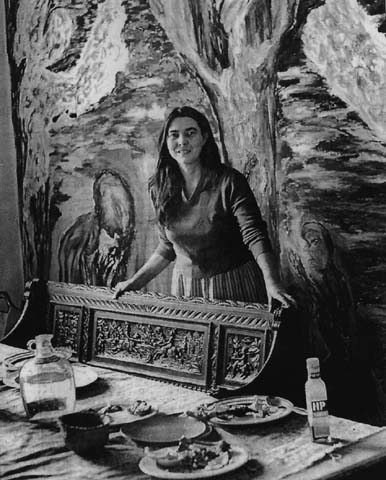 |
Obituaries |
The Herald Glasgow July 2001
Mary Barnes
Artist who found her talent after 'journey through
madness' in R D Laing's experimental community

THE FIRST half of Mary Barnes's life was unremarkable in its private unhappiness and descent into madness. In the second half, however she achieved international recognition as a painter, writer, and poet and as living proof of the potential of R D Laing's radical psychiatry of the 1960s.
The story of her stay in the London experimental community Kingsley Hall, which Laing founded with colleagues in the Philadelphia Association, was told in the book Two Accounts of a Journey Through Madness.
It was written jointly by Mary Barnes and the American psychiatrist Joseph Berke, who, newly qualified and fascinated by Laing's ideas, accepted personal responsibility for working with her.
The book described, from the point of view of each author, Mary's dramatic disintegration into infantile behaviour and her slow, painful reintegration as a creative adult.
David Edgar's play Mary Barnes, later produced at Glasgow's Citizens Theatre, was based on this book.
Born in 1923, Barnes was the eldest daughter of a conventional middle?class family, with parents crippled in their capacity to communicate with each other or with their children.
Both Mary and her younger brother manifested symptoms, which in adult life developed into psychotic behaviour.
Her brother was frequently in and out of mental hospital, but Mary, who had become a nurse, managed to keep her symptoms under control until her mid-forties, when she recognised her need for professional help.
What was extraordinary was her intuitive recognition of the unorthodox form of therapy she needed. Having found her way to Laing, she was given a room in Kingsley Hall when it opened.
The "journey" took five years, years which tested the tolerance of the other members of the community and Joe Berke to the limit.
Regression to infantile behaviour was precisely that. She wet and soiled herself and was uninhibited in expressing feelings of rage and fear. She was needy, greedy, and intolerably demanding, and this alternated with fear and guilt, which led her to reject food for long periods. Some of her behaviour involved painting her faeces on walls and on her body. Central to her recovery was Berke's capacity to accept this behaviour as an expression of an inner need and to respond by bathing her, putting her to bed, and feeding her milk.
it was the smearing of faeces on walls that led Berke to offer her paper and crayons as an alternative way of expressing herself. The result was astonishing.
To quote Berke, her art, unadulterated by training or inhibition, "came screaming out of her psyche".
it was deeply influenced by her religious conviction. She had earlier converted to Catholicism and from the beginning used classical images from both the Jewish and Christian scriptures ? particularly, in the early stage, the Madonna and Child, an image to which she had a particular devotion.
Her paintings, however, have an archetypal quality, which transcends any specific set of beliefs. The most enduring image, to which she constantly returned, was that of the Crucifixion. In this she appeared to convey not only the agony of the cross but the joy of the resurrection, a reflection perhaps of her own experience.
Her paintings have been photographed, filmed, and exhibited in major cities all over Europe, in Scandinavia as well as in St Andrews, Kirkcaldy, and, most recently, in the Project Ability Gallery in Glasgow.
At this last exhibition three of her paintings were acquired by Glasgow Art Galleries and Museum for the city she loved Scotland, initially because it was R D Laing's homeland, but came to love it for its own sake and made her final home in Tomintoul.
Her last years were dominated by physical ill-health, but her spirit stayed strong and she painted until the last weeks of her life. Her death was remarkably peaceful for a woman whose life had been such a struggle.
Mary would have loved her funeral service, which took place in the beautiful private chapel of Falkland Palace. It had all the colour and glamour that so satisfied her senses and informed her art but she was also surrounded by friends and protectors who expressed the appreciation of her existence that she had so hungered for and been denied as a child.
Mary Barnes, artist; born February 9, 1923, died June 30,2001
.....................................
KAY CARMICHAEL